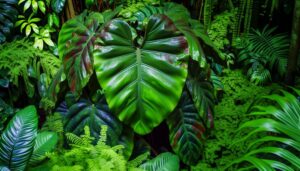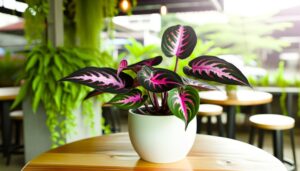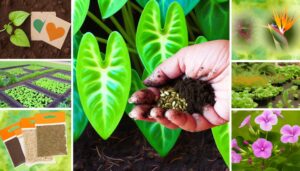What Is a Philodendron Erubescens Emerald Queen?
The Philodendron erubescens 'Emerald Queen' is a sturdy tropical plant celebrated for its lush, shiny heart-shaped leaves, which reach up to 30 cm in length. Native to Central and South American rainforests, it thrives in humid, shaded conditions with well-draining, organic-rich soil.
This species exhibits an indeterminate growth habit, often utilizing aerial roots for support. Ideal care includes bright, indirect light and maintaining 60-80% moisture levels.
Propagation is effectively achieved through stem cuttings. With proactive care, it remains resilient against common issues such as root rot and pest infestations.
To explore more detailed care guidelines, consider examining additional details provided.
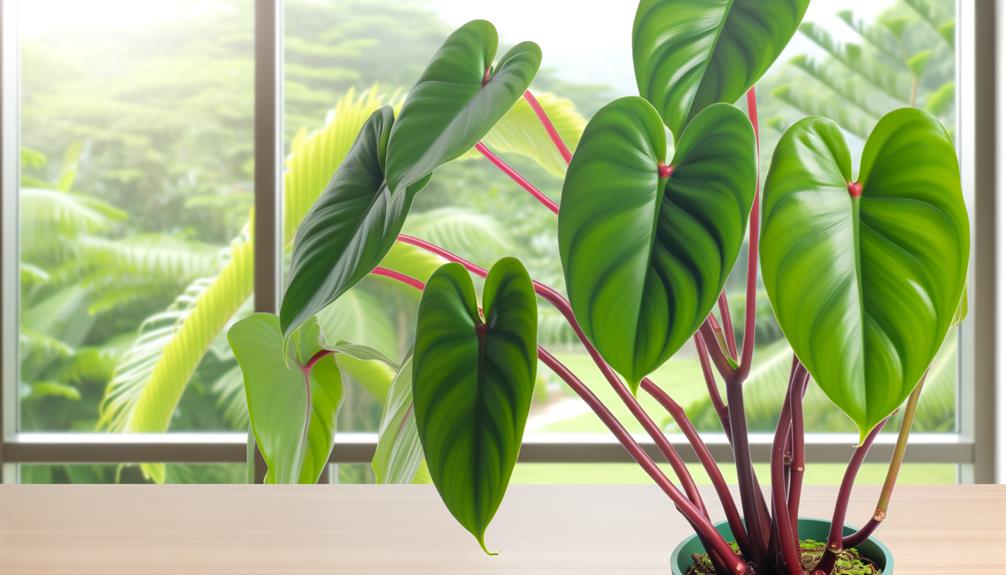
Key Takeaways
- Philodendron Erubescens Emerald Queen: A tropical plant with glossy, heart-shaped emerald green leaves.
- Growth Habit: Features indeterminate growth, allowing it to climb or sprawl with robust petioles.
- Natural Habitat: Native to the humid, shaded rainforests of Central and South America.
- Care Requirements: Thrives in well-draining, organic-rich soil with bright, indirect light and high humidity.
- Propagation: Easily propagated through stem cuttings with at least one node and aerial root.
Characteristics and Appearance
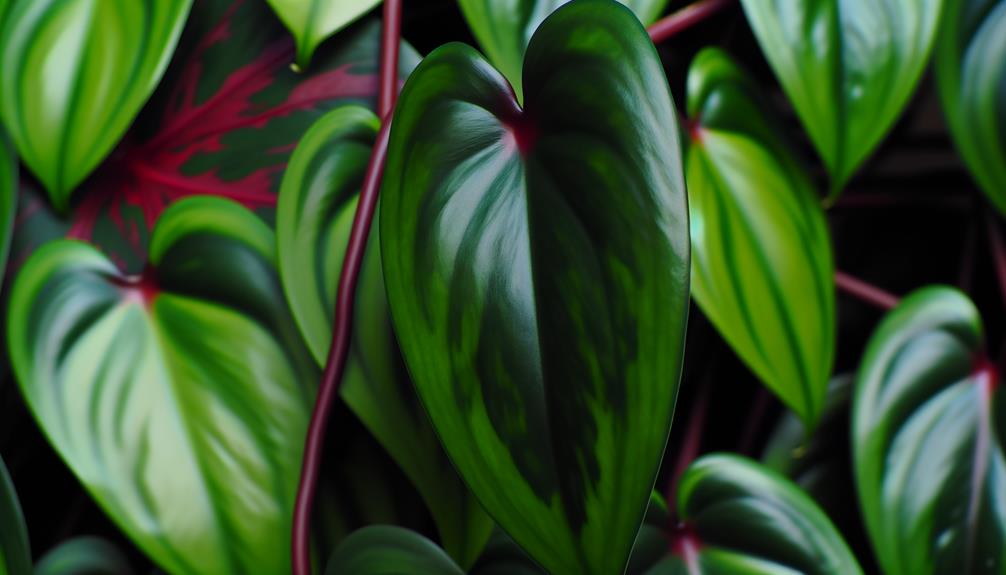
Philodendron erubescens 'Emerald Queen' is characterized by its glossy, heart-shaped leaves that exhibit a vibrant emerald green hue, often reaching lengths of up to 30 cm. The foliage is noted for its luxuriant texture, with a smooth, almost waxy surface that enhances its vivid coloration. The petioles, robust and sturdy, support the large leaves efficiently, contributing to the plant's overall structural integrity.
Additionally, the 'Emerald Queen' exhibits an indeterminate growth habit, allowing it to climb or sprawl as it matures. The stems, typically tinged with a subtle reddish hue, contrast elegantly with the green leaves. This philodendron variety is also appreciated for its relatively fast growth rate, making it a popular choice among horticulturists and plant enthusiasts.
Natural Habitat
Indigenous to the tropical rainforests of Central and South America, Philodendron erubescens 'Emerald Queen' thrives in humid, shaded environments where it typically ascends tree trunks and large shrubs.
This hemiepiphytic species utilizes its aerial roots to anchor itself onto host plants, gaining access to filtered sunlight beneath the dense canopy. The ecosystem provides a warm, consistently moist climate with high relative humidity, often exceeding 70%.
The soil in these regions is rich in organic matter, facilitating robust nutrient uptake. Additionally, the microclimate within these rainforests shields the plant from direct sunlight, preventing leaf scorch and ensuring best photosynthesis.
These natural conditions are optimal for the 'Emerald Queen's' growth, contributing to its lush, vibrant foliage and vigorous climbing habit.
Care Requirements
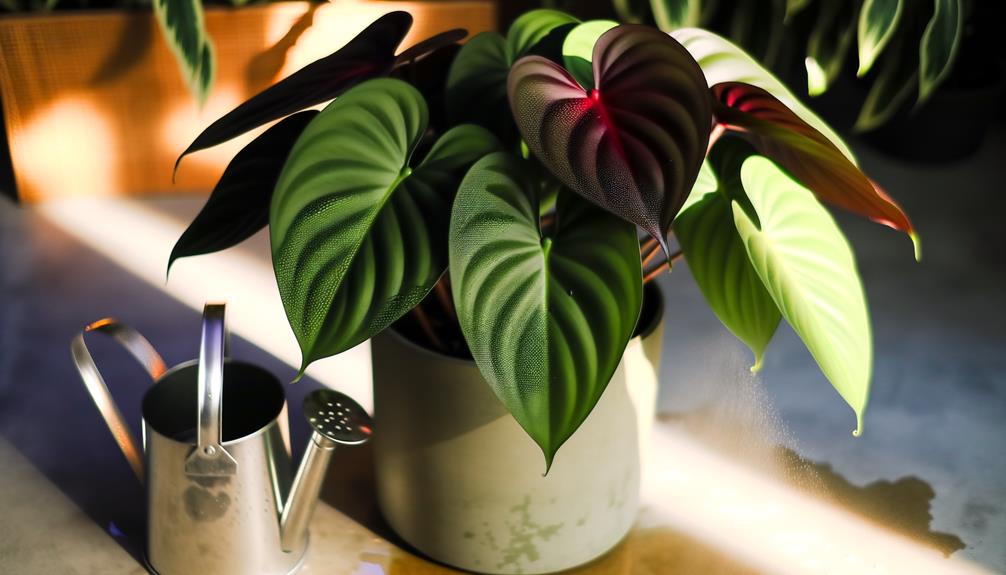
To replicate the best conditions of its natural habitat for Philodendron erubescens 'Emerald Queen', maintaining high moisture levels, indirect light, and well-draining, organic-rich soil is crucial. This species thrives in environments where relative moisture consistently hovers around 60-80%.
Position the plant in an area with bright, indirect light to simulate the dappled sunlight of tropical understories. The substrate should be a mix of peat moss, perlite, and orchid bark to guarantee proper aeration and drainage.
- Moisture: Maintain 60-80% for prime growth.
- Light: Bright, indirect light to mimic natural conditions.
- Soil: Well-draining, organic-rich mix (peat moss, perlite, orchid bark).
Regularly monitor moisture levels to prevent root rot, ensuring a healthy Philodendron erubescens 'Emerald Queen'.
Propagation Methods
Utilizing stem cuttings is the most effective method for propagating Philodendron erubescens 'Emerald Queen', ensuring genetic consistency and robust growth. This technique involves selecting a healthy stem with at least one node and aerial root.
The chosen stem should be severed using sterilized pruning shears to prevent pathogen transmission. The cutting must then be placed in water or a well-draining propagation medium such as sphagnum moss or perlite. Ensuring ideal conditions, such as high humidity and indirect light, promotes root development.
Root initiation typically occurs within 2-4 weeks, after which the cutting can be transferred to a potting mix. Regular monitoring for signs of growth and maintaining consistent moisture levels are essential for successful propagation.
Common Issues and Solutions

While propagation of Philodendron erubescens 'Emerald Queen' maintains genetic consistency and robust growth, several common issues can impede the health and development of the plant.
Root rot, often caused by Pythium spp. or Phytophthora spp., results from excessive moisture and poor drainage. It is crucial to maintain well-draining soil and reduce watering frequency to prevent this issue.
Pest infestations, such as those by Aphidoidea (aphids) and Tetranychidae (spider mites), can lead to chlorosis and stunted growth. Regularly inspecting the plant and treating with appropriate insecticides can help control these pests.
Nutrient deficiencies, particularly of nitrogen (N), phosphorus (P), and potassium (K), manifest as yellowing leaves and reduced vigor. Utilizing balanced fertilizers to maintain ideal nutrient levels is essential for addressing these deficiencies.
These proactive measures can help ensure the continued health and vitality of Philodendron erubescens 'Emerald Queen'.
- Root Rot: Maintain well-draining soil and reduce watering frequency.
- Pest Infestations: Regularly inspect and treat with appropriate insecticides.
- Nutrient Deficiencies: Utilize balanced fertilizers to maintain ideal nutrient levels.
Conclusion
The Philodendron erubescens 'Emerald Queen,' known for its vibrant green leaves and strong growth, flourishes in humid, tropical climates. Needing indirect sunlight, well-draining soil, and regular watering, it requires careful attention for best health.
Reproduction through stem cuttings is effective. Common problems include pest attacks and root decay, which can be reduced through correct cultural methods.
The hypothesis that its photosynthetic effectiveness exceeds that of other indoor plants in dim light situations requires additional empirical research to support assertions.


